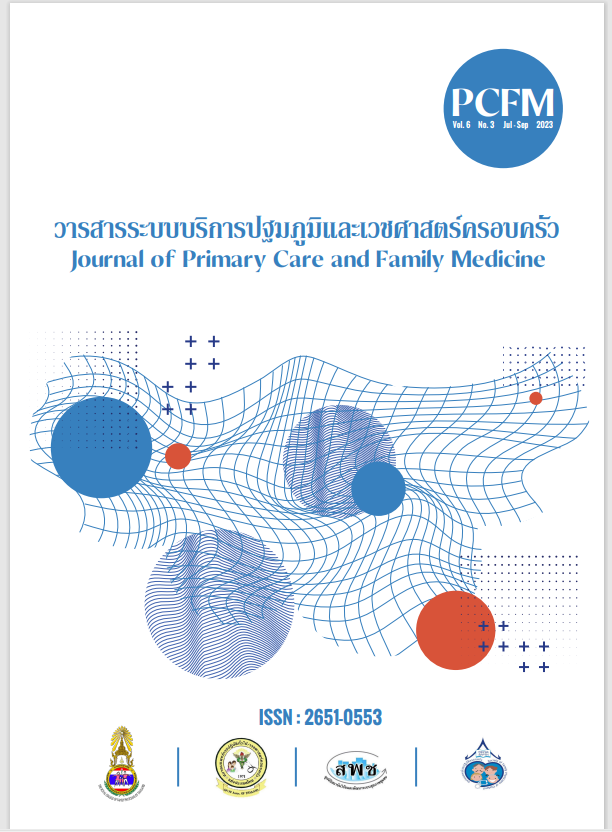เทคนิคการคืนข้อมูลเพื่อสร้างความตระหนักรู้ในการควบคุมระดับน้ำตาลในเลือดด้วยตนเอง ของผู้ป่วยเบาหวานในศูนย์สุขภาพชุมชนเขตเมือง
Main Article Content
บทคัดย่อ
ที่มาและวัตถุประสงค์: เทคนิคการคืนข้อมูลเพื่อสร้างความตระหนักรู้ในการควบคุมระดับน้ำตาลในเลือดด้วยตนเอง
ของผู้ป่วยเบาหวานในศูนย์สุขภาพชุมชนเขตเมือง มีกระบวนการการคืนข้อมูลเพื่อสร้างความตระหนักรู้ด้วยทีมสหวิชาชีพและการเจาะน้ำตาลในเลือดด้วยตนเอง (self-monitoring of blood glucose, SMBG) ให้กลุ่มผู้ป่วยเบาหวานที่ไม่สามารถควบคุมระดับน้ำตาลได้ (HbA1C> 7 mg%) ใน 5 ศูนย์สุขภาพชุมชนเขตเมือง เครือข่ายโรงพยาบาลสุราษฎร์ธานีเพี่อเปรียบเทียบความรู้ การปรับเปลี่ยนพฤติกรรม และค่าระดับน้ำตาลในเลือด ก่อนและหลังให้เทคนิคการคืนข้อมูล
วัสดุและวิธีการ: เป็นการวิจัยแบบผสมผสาน (Mixed-methods study) กลุ่มผู้ป่วยเบาหวานที่ไม่สามารถควบคุมระดับน้ำตาลได้ โดยใช้แบบสอบถามและสุ่มสัมภาษณ์เชิงลึก เก็บรวบรวมข้อมูลระหว่างวันที่ 1 กรกฎาคม 2563 -1 มิถุนายน 2564 วิเคราะห์ข้อมูลด้วยสถิติพรรณนา เปรียบเทียบความรู้ พฤติกรรมและระดับน้ำตาลในเลือดก่อนหลังเข้าร่วมวิจัยโดยใช้สถิติ Paired t-test, Wilcoxon Signed Ranks Test และ Friedman test
ผลการศึกษา: กลุ่มตัวอย่างจำนวน 88 คน มีคะแนนเฉลี่ยของความรู้และพฤติกรรมการดูแลตนเองหลังเข้าร่วมวิจัย มากกว่าก่อนเข้าร่วมวิจัยอย่างมีนัยสำคัญทางสถิติ โดยค่าเฉลี่ยคะแนนความรู้ที่เพิ่มขึ้น =12.73, =15.15, P <0.001 และค่าเฉลี่ยคะแนนพฤติกรรมที่เพิ่มขึ้น =37.74, =39.57, P.001 ตามลำดับ ผู้ที่คุมระดับ FBS ได้ก่อนเข้าร่วมวิจัยร้อยละ 18.2 เพิ่มขึ้นเป็น 40.7 หลังเข้าร่วมวิจัย ส่วนการคุมระดับ HbA1C ได้ ก่อนเข้าร่วมวิจัยมีร้อยละ 1.1 หลังเข้าร่วมวิจัย 3และ6 เดือนเพิ่มขึ้นเป็น 35.3 และ 13.9 ตามลำดับ เมื่อเปรียบเทียบระดับ FBS สถิติ Wilcoxon Signed Ranks Test พบว่า ค่าเฉลี่ยก่อนเข้าร่วมวิจัย ( =170.65, S.D.=51.61) และหลังเข้าร่วมวิจัย ( =141.56, S.D.=36.56) แตกต่างกันอย่างมีนัยสำคัญทางสถิติที่ระดับ .001 ส่วนการเปรียบเทียบระดับ HbA1C ด้วยสถิติ Friedman test พบว่า ค่าเฉลี่ยก่อนเข้าร่วมวิจัย ( =8.64, S.D.=1.36) หลังเข้าร่วมวิจัย 3 เดือน ( =7.60, S.D.=1.33) และหลังเข้าร่วมวิจัย 6 เดือน ( =8.37, S.D.=1.60) แตกต่างกันอย่างมีนัยสำคัญทางสถิติที่ระดับ .001 เช่นกัน
สรุปผล: การคืนข้อมูลเพื่อสร้างความตระหนักรู้ในการควบคุมระดับน้ำตาลในเลือดด้วยตนเองด้วยชุดความรู้จากทีมเจ้าหน้าที่ การคืนข้อมูลด้วยตนเองจากการตรวจ SMBG มีผลต่อความรู้ การปรับเปลี่ยนพฤติกรรม และค่าระดับน้ำตาลในเลือดที่ดีขึ้น ดังนั้นคลินิกผู้ป่วยเบาหวาน ควรมีการให้ความรู้อย่างเป็นระบบและสนับสนุนให้ผู้ป่วยเห็นความสำคัญในการเจาะน้ำตาลในเลือดด้วยตนเองเพื่อสร้างความตระหนักรู้ต่อการเลือกรับประทานเมนูอาหารที่เหมาะสมทำให้เกิดการปรับเปลี่ยนพฤติกรรมอย่างยั่งยืนและลดภาวะแทรกซ้อนจากโรคเบาหวาน
Article Details

This work is licensed under a Creative Commons Attribution-NonCommercial-NoDerivatives 4.0 International License.
เนื้อหาและข้อมูลในบทความที่ลงตีพิมพ์ในวารสาร PCFM ถือเป็นข้อคิดเห็นและความรับผิดชอบของผู้เขียนบทความโดยตรง ซึ่งกองบรรณาธิการวารสารไม่จำเป็นต้องเห็นด้วยหรือร่วมรับผิดชอบใด ๆ
บทความ ข้อมูล เนื้อหา รูปภาพ ฯลฯ ที่ได้รับการตีพิมพ์ลงในวารสาร PCFM ถือเป็นลิขสิทธิ์ของวารสาร PCFM หากบุคคลหรือหน่วยงานใดต้องการนำทั้งหมดหรือส่วนหนึ่งส่วนใดไปเผยแพร่ต่อหรือเพื่อกระทำการใด ๆ จะต้องได้รับอนุญาตเป็นลายลักษณ์อักษรจากวารสาร PCFM ก่อนเท่านั้น
References
สำนักโรคไม่ติดต่อกรมควบคุมโรค. ข้อมูลโรคไม่ติดต่อจำนวนอัตราป่วย ตาย ปี 2559-2562[อินเตอร์เน็ต]. [เข้าถึงเมื่อ 13 มีนาคม 2563] เข้าถึงได้จาก http://www.thaincd.com/2016/mission/documents-detail.php?id=13893&tid=32&gid=1-020
โสภา ไชยแก้ว. การเสริมสร้างแรงจูงใจในการปรับเปลี่ยนพฤติกรรมในผู้ป่วยเบาหวาน ความดันโลหิตสูงโรงพยาบาลส่งเสริมสุขภาพตำบลท่าข้าม อำเภอเมืองเชียงใหม่ จังหวัดเชียงใหม่ [อินเตอร์เน็ต]. [เข้าถึงเมื่อ 4 มกราคม 2565] เข้าถึงได้จาก https://www.nkp-hospital.go.th/th/H.ed/mFile/20201117144657.pdf
รัตนาภรณ์ จีระวัฒนะ และคณะ. แนวปฏิบัติการทำกิจกรรมกลุ่มเบาหวาน เพื่อพัฒนาความสามารถในการดูแลตนเองและตอบสนองความต้องการของผู้เป็นเบาหวานรายบุคคล. กรุงเทพมหานคร. บริษัทคอนเซ็พท์เมดิคัสจำกัด 2563; 37.
Becker MH. The Health Belief Model and Personal Health Behavior. Health Education Monographs 1974; 2: 324- 508.
Bloom BS. Learning for mastery. Evaluation comment. Center for the study of instruction program. University of California 1968; 2 :47-62.
เพ็ญศรี พงษ์ประภาพันธ์, สุวิมล แสนเวียงจันทร์ และประทีป ปัญญา. การพัฒนารูปแบบการส่งเสริมสุขภาพแบบองค์รวมของผู้ป่วยเบาหวานในชุมชนวัดปุรณาวาส [อินเตอร์เน็ต]. [เข้าถึงเมื่อ 19 มีนาคม 2563] เข้าถึงได้จาก https://he02.tci-thaijo.org/index.php/tnaph/article/view/4764.
Prochaska J, DiClemente C. Stages and processes of self-change of smoking: toward an integrative model of change. Journal of Consulting and Clinical Psychology; 1983; 51(3), 390–395.
กรมการแพทย์. รูปแบบการดูแลผู้ป่วยโรคเรื้อรัง Chronic Care Model [อินเตอร์เน็ต]. [เข้าถึงเมื่อ 13 มกราคม 2566] เข้าถึงได้จาก http://training.dms.moph.go.th/rtdc//storage/app/uploads/public/5d2/541/b4b/5d2541b4bbb05671313444.pdf
International Diabetes Federation. Guideline: Self-monitoring of blood glucose in noninsulin treated type 2 diabetes; 2009.
Towfigh A, Romanova M, Weinreb JE, et al. Self-monitoring of blood glucose levels in patients with type 2 diabetes mellitus not taking insulin: A meta-analysis. Am J Manag Care 2008; 14: 468-75.
Boutati EI, Raptis SA. Self-monitoring of blood glucose as part of the integral care of type 2 diabetes. Diabetes Care 2009; 32 (Suppl2): S205-S210.
American Diabetes Association. Standard of medical care in diabetes 2017. Diabetes Care 2017; 40 (Suppl 1): S48-S56.
Andrew J, Palmer, Sean D, et al. Cost-utility analysis in a UK setting of self-monitoring of blood glucose in patients with type2 diabetes. Curr Med Res opin 2006; 861-872.
Polonsky WH, Fisher L, Schikman CH, et al. Structured self-monitoring of blood glucose significantly reduces A1C levels in poorly controlled noninsulin-treated type 2 diabetes: results from the Structured Testing Program study. Diabetes Care 2011; 34: 262–67.
Subhankar C, Linong Ji, Sompongse S, et al. Practical approaches for self-monitoring of blood glucose: an Asia-Pacific perspective. Curr Med Res opin; 2015; 461-476.

